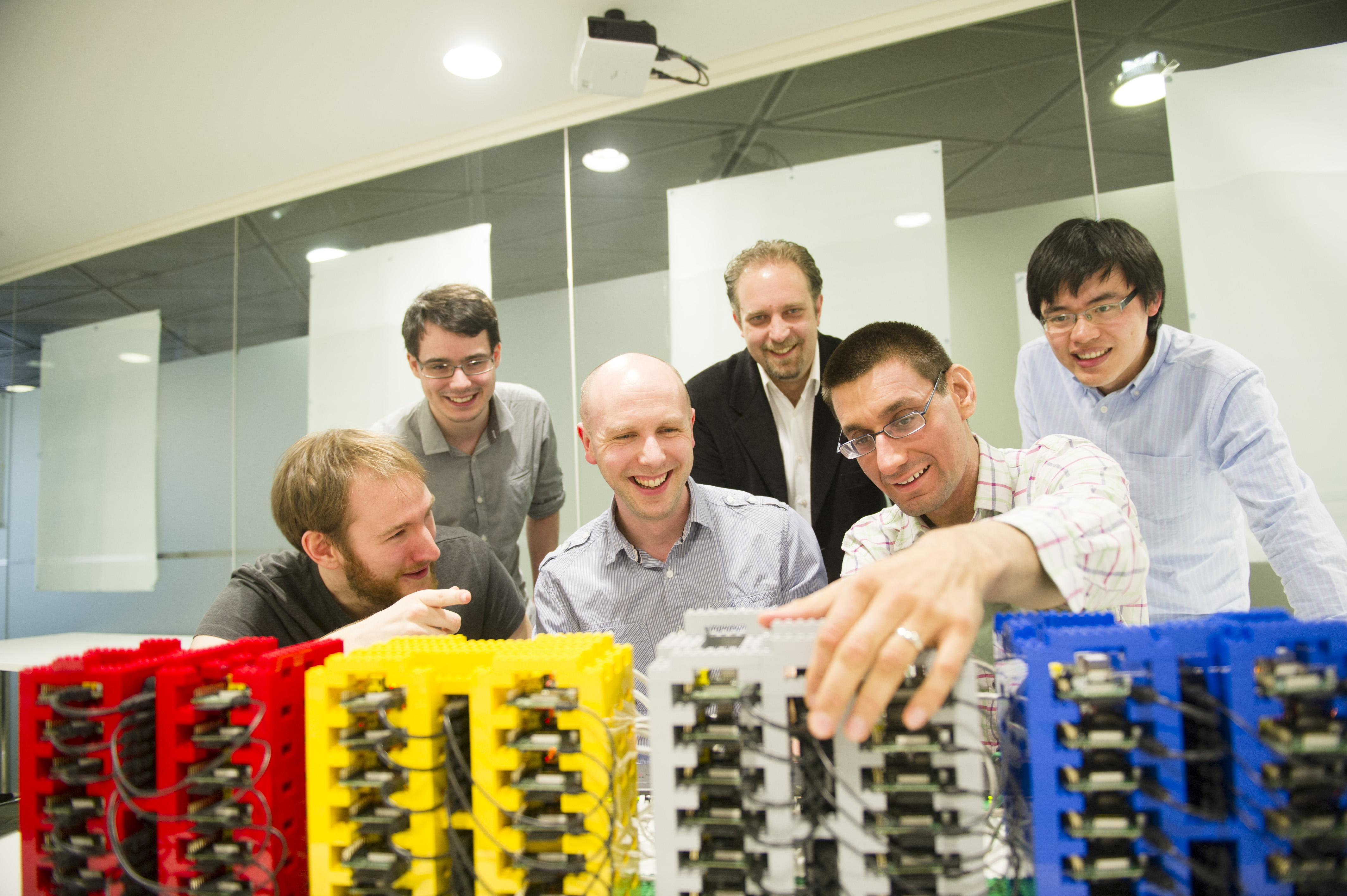

There are lots of fun things you can do with those lovely bite-size Raspberry-Pi machines. You can program games, create a time-lapse photography system, or even use them as base stations for mobile networks.
Back in 2012, engineers from University of Southampton, assisted by a six-year-old boy, rather impressively constructed a supercomputer using 64 Raspberry Pis and some Lego.
Researchers at the University of Glasgow have taken a different approach. Using 56 of the credit card-sized machines, they’ve built a small cloud-like data centre, on an initial investment of just £4,000. Have a look at it in all its Lego-based glory in the gallery below.
But why bother building a Raspberry-Pi Cloud in the first place? Are they just showing off? Should IT managers beg for a bigger Lego budget? We caught up with Dr David White of the University’s School of Computing Science to talk about what they’re doing with their creation and how big they plan to make it.
We had the idea in early 2012, and the project funding was granted by the Chancellor’s Fund for Teaching and Learning here at Glasgow about a year ago. We started physically constructing the main PiCloud (as opposed to prototypes) in October 2012.
Take us through the process of how you came up with the idea, how you decided on architecture and any problems you’ve had.
Well, we’d been working on cloud computing and trying to evaluate our research ideas. Simulation is a popular way of evaluating work and teaching concepts, but it is also often criticised for a lack of accuracy and realism. Previously, Dr Posco Tso had constructed a physical testbed using commodity PCs, but it was becoming unmanageable, expensive, noisy and hot – necessitating relocation to a machine room. We needed something more.
We realised at the same time that teaching cloud computing was limited to a “black box” approach simply using commercial cloud services rather than students getting “under the hood” and seeing how they might engineer a cloud. There’s a parallel between this problem and the issue of “hermetically sealed” computing – that today’s kids are no longer exposed to hardware or to an underlying operating system in the same way that perhaps was common in the 1980s. The Raspberry Pi project set out to address this issue and appeared at the same time as we were thinking about the cloud, and the two ideas combined to produce a really great platform.
It’s more than just that, though. We also wanted to do something different, try something new – no-one had to produce a “scale model” like this before, and we were interested to see whether it was possible, and how successful it would be. The response from the students has been overwhelmingly positive, and we’re looking forward to seeing how having this platform available can enhance our research.
In terms of problems – the first was to get hold of enough Raspberry Pi devices! There’s been so much enthusiasm about the Raspberry Pi! Selecting hardware components and designing the physical arrangement took quite a bit of time – but the students at Glasgow enjoy a challenge and have been working hard, with some of them spending their spare time constructing the PiCloud.
What kinds of processes have you been running on it?
Hadoop, artificial workloads, and lightweight webservers such as lighttpd. This is not a computation cluster.
How far do you want it to scale out?
In terms of the number of Pi devices? I don’t see any immediate bottlenecks… we’d like to take it up to 1000 and I don’t see any insurmountable technical problems with doing this.
What hypervisors are you using?
None – we’re using Linux Containers (LXC), so in effect our “hypervisor” is a single Linux kernel, which then shares the machine between multiple (somewhat isolated) containers, each containing a Linux distribution.
Is it feeding back into other storage systems and how is it connected to other networks?
We use the onboard SD cards for most storage, although we intend to move to network storage. It’s linked to a single controlling PC, which obviously has large space available.
Do you think this proves you don’t need to spend extraordinary sums to get a private cloud up and running in a business?
I don’t think so – it’s not computationally powerful enough to function as a commercial cloud. The main limits on the Pi’s are RAM (256MB, now 512MB – most of our’s are 256MB) and the clock speed.
Think you can design something special with a Raspberry Pi? Enter our Office Gadget competition and you can get £250 worth of kit to build it!
Denial from TSMC, after multiple reports it was in talks with Intel over a joint…
CEO Tim Cook talks to Trump official, as IDC notes China's smartphone market growth, and…
Another big name chip maker expects a hefty financial charge, after the US tightened rules…
More bad news for Google. Second time in less than a year that some part…
Federal office that tackled misinformation and disinformation from hostile nations is closed down, after criticism…
After Nvidia admits it will take $5.5 billion charge as Trump export limits of slower…
View Comments
The 5x2 button Lego piece. Is the ideal model for a seacontainer 8x8x20
Every architect should order a container filled with 5x2 pieces for making a maquette for the LONDON CONTAINER HARBOUR. Jan Haije